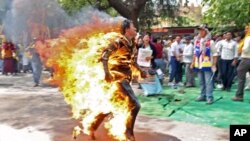A year of self-immolation protests by Tibetans reached exiles in India, when one of their own set himself on fire last month. A new generation is preparing to take up the Tibetan cause in northern India.
Young Tibetans play at school recess on a bright April day. They wear the traditional clothing of a homeland they have never seen. This is Dharamsala, India. Tibetan spiritual leader the Dalai Lama came here in 1959 with tens of thousands of followers, and set up a de-facto exile capital.
The clothes, and a stepped up effort to speak Tibetan, are part of the so-called “White Wednesday” that mirrors a parallel movement of passive resistance in Tibetan areas under Chinese control.
Lately, the children also have been learning about another kind of resistance, by Tibetans who have chosen to set themselves on fire.
Furthering the Tibetan cause
In the past year, there have been 34 fatal self-immolations to protest Chinese policies. Teacher Dolma Nyima faces the challenge of teaching the kids why someone would take such a drastic step.
“During our assembly, we show them the picture - how the people have self-immolated. And when they see the picture, they are emotional. It changes all of their expressions. Some children are asking, 'Oh teacher, will we have to do like this?”
Twenty-seven-year-old Jamphel Yeshi became the first of this year’s self-immolations to take his life on Indian soil. He ran through the streets of New Delhi ablaze on March 26, just days before the scheduled arrival of Chinese President Hu Jintao. Activist posters plastered around Dharamsala celebrate him as a “martyr.”
Tibetan Youth Congress General Secretary Tenzin Chokey helps print the posters.
“I am sure in the Western context these images are not allowed to be shown to kids at all. But here we are, you know, this is the reality," said Tenzin.
Children flock to funeral
School children were among the thousands who lined the recent funeral procession route of Yeshi through the streets of Dharamsala.
“There were people lined up, we expected that. And I knew school kids would also be lining up. But to see them, you know, with the flags, that was a very, very emotional moment for me,” said Tenzin.
The United States government funds a reception center in Dharamsala for Tibetans who flee persecution at home.
A 27-year-old who arrived about a month-and-a-half ago says what motivated him to leave was cultural repression.
He said he had a tiny picture of His Holiness the Dalai Lama around his neck. The Chinese soldiers ripped it off. They beat him first, he said, and asked questions later.
Tibetan exiles see themselves as the inevitable winner of a historical contest of endurance against the Chinese Communist Party.
But if the 76-year-old Dalai Lama dies without returning home to Tibet, it is an open question whether young Tibetans, in exile or at home, will be able to contain their anger.










